Please support Game Informer. Print magazine subscriptions are less than $2 per issue
Afterwords – Assassin's Creed Syndicate

Assassin's Creed Syndicate is a step in the right direction for Ubisoft's annual series – especially considering the disastrous release of Assassin's Creed Unity in 2014. However, Syndicate isn't only good because it avoids the pitfalls of its predecessor; it combines some fun elements of older entries while adding its own spin on the formula (read our review). We spoke to game director Scott Phillips about the process of creating Syndicate and the decisions the team had to make along the way.
Note: Some of the following answers include story spoilers.
Our team talked to you several years back when we did a cover story on Saints Row: The Third. Even though that’s a much goofier series, what were some lessons you learned from it that you applied to Syndicate?
Making sure that the player has fun and focusing on the player experience first was stuff that I brought forward from Saints Row. I tried to remind everyone – game design, level design, art, audio – to make sure to celebrate the players and make sure they’re enjoying their time with the game. Leave a lot of opportunities for them to express themselves and try new things – and to surprise us as developers. I think that comes through in Syndicate.
The perks are especially reminiscent of Saints Row, giving passive bonuses for things like destroying objects or performing assassinations.
That idea is in a lot of games, but taking the actions the player would normally do and providing rewards for them is key. Reminding the player that, “Hey, keep doing what you’re doing! We’re going to reward you constantly!” That’s key to making sure the player is having fun and the experience is positive.
Unity’s issues dominated the conversation about Assassin's Creed last fall. Did those problems impact the culture around development of Syndicate?
We knew, coming from Unity, that we needed to focus and make sure we delivered a polished and high-quality product. We made decisions like not supporting co-op and not supporting a companion app to focus our efforts and make the best Assassin’s Creed we could. [Unity] affected us, for sure. We had to make decisions based on the reception, just as any game would on a previous game. I think we made the right decisions, and I think that shows in the quality of the game we delivered.
A series with as many entries as Assassin’s Creed has dabbled in too many features to include in a single game. How did you identify which old elements to focus on and refine, and which ones to leave behind?
With Assassin’s Creed, it’s really helpful that the series is all about time travel. Because you’re in a new location and a new time period, with new protagonists and antagonists, it allows us to focus our efforts on what we think will deliver that experience the best. If we don’t feel like a feature from a past Assassin’s Creed fits for our setting, then it’s easy to say “No, we’re not going to carry that forward.” On the other side, we also have features that we need to add, so I think things like the rope launcher really speak to our time period and setting. We add and subtract based on the setting, and it keeps it fresh for each entry in the franchise.
Yeah, you couldn’t really implement sailing down the Thames, right?
We considered how we would do the Thames, and when you look at what it was like historically, it was packed full of ships – as we have it represented. It was constantly moving ships, so yeah, it would not have been an enjoyable boat experience.
The rope launcher is a great tool. During development, did you have any reservations about de-emphasizing the climbing elements that have been a pillar of the series for so long?
There were concerns, sure. As you said, a core of the franchise has been the parkour. But it’s one of those things where, once you start playing with it, it’s a completely different experience than hearing about it. Trying to play without the rope launcher, I think, is a more challenging experience. To what I mentioned earlier, it’s less fun to just have the parkour; we felt like the rope launch added a lot to the player experience of London 1868.

Do you have to do any coordination with the team making the next Assassin’s Creed game when implementing formula-changing ideas? Or is that managed from a broader brand perspective?
There’s definitely a team that shepherds the Assassin’s Creed brand. They take all aspects of the franchise and look at where it’s going and what it should be. To what I had said earlier, the setting of any game determines the feature set and what is available, so whatever location we’re doing is going to drive what gets in the game.
Carriages, by their nature, aren’t going to be as exciting or control as well as the cars that players are used to driving in open-world games. Was that a point of concern for the team?
We aimed for the controls to be fun, intuitive, and easy-to-use, and I think we delivered on that. In terms of how they move, the carriages are being pulled by living animals. They have their own A.I., so if you jump on top and start fighting, the carriage is going to continue moving, which you can’t really say with a car. So, there are differences in how they function. We wanted to make sure that you could jump right into it…we balanced it toward the “fun” side.
The World War I sequence shows up on the map without much fanfare. Many games would specifically direct players to a sequence like that; why did you decide to have players discover it on their own?
A lot of discussions went on about how exactly to introduce the World War I setting. How you would get in the portal? Would it be a mission? Would it be in the open world? Would we inform you about it? The way we ended up doing it is allowing players to find it. We give you an icon; it’s not necessarily hidden. Not everyone is going to find it immediately, but I think that’s good – it’s good to have things that people can chat about around the water cooler.
Why is Sequence 8 an option from the beginning?
We wanted to allow the player to engage with the open world right away. Because of the narrative setting – Maxwell Roth is the Templar gang leader – the focus of the open world was about destroying the Templar control of the city, so it made sense to allow the player to destroy that control at any point within the experience. And we didn’t necessarily want to say, “You’ve taken over the entirety of London, but there’s still a gang leader Templar out there that you need to wait until this specific point in the story in order to fight him.” We wanted it to be more organic because, for that character, it made a whole lot of sense for him to be available.
But don’t you need to conquer a certain number of boroughs before you can even engage with that sequence?
Yeah, the narrative set-up was that, to even be considered for talking to Maxwell Roth, you needed to show up as a threat. So you needed to take over three neighborhoods to show that the Frye twins were a real threat to the Templar and Blighter control of the city…Having it as “Sequence 8” can lead to some players thinking they should play in a certain order, but we wanted to open it up and let them experiment more with the open world.
Syndicate features more fluid multi-enemy combat than Unity. Was that a specific goal for the game?
One of the pillars of that experience we wanted was crowd control. We wanted you to be able to bounce quickly back and forth between targets. We wanted to move away from the focus on defense and waiting and parrying. We wanted the player to always be on the offensive. To get the best outcome – to earn the most experience and get the most impressive kills – the way to do it is to bring multiple enemies down to near-death and then finish them all off at once. It’s a unique experience with a lot of great finishing moments.

During some of those finishers, enemies just stand around and watch. How do you balance the sense of fighting a group with the desire to let players feel powerful?
Like you said, it’s all about balance, and we want that balance to be in the player’s favor. [Enemies] are not going to attack as much in a frustrating manner. They’re not going to deny you your attacks super-often. It’s a player-focused experience about crowd control and about being really brutal and visceral and violent in close-quarters with the combat. The balance was about making sure the player was always on the offensive, so that was the desired experience.
Previous Assassin’s Creed titles have taken different approaches to weapons, from giving players lots of choices to practically none. How did you land on the three weapon categories in Syndicate?
I think they were iconic weapons in terms of representing London at the time. The brass knuckles are very close-quarters, very violent and brutish. The cane sword is more stylish, maybe more elegant. And then you’ve got the kukri, which brings a little of the Indian culture – the Henry Green style – into the world. So, we felt like those were three relevant aspects to the setting.
Microtransactions are a business need, not necessarily a thing everyone dreams of putting in their games. How did you approach their implementation in Syndicate?
It’s tricky. We try to get the interface early so we get a sense of how it feels in the experience. We want to make sure that it’s visible but not too visible; it’s always a balancing act. I think some of the stuff we did – you get Helix credits by picking up collectibles – we tried to entice players to use some of it if they wanted to, but they didn’t really have to engage with it any further if they didn’t want to.
In the past, different entries have had close connections – from the Ezio trilogy to the those involving the Kenways. Is Jacob and Evie’s story a standalone tale, or is it the beginning of a new connected thread?
That one I can’t really answer, since Assassin’s Creed has a brand team running it. For me, my focus was solely on Assassin’s Creed Syndicate.
We’ve had several games setting up various modern story elements, too. How do you focus on an interesting story in the past while still advancing the present-day arc for the the devoted fans?
It’s a lot of discussion and a lot of back-and-forth. The amount that each Assassin’s Creed game is different; what we did with the WWI time anomaly was, I think, good with allowing players to engage with the Juno storyline and learn more about that. It’s about finding the right balance for new players, for fans of the franchise – which I would consider myself. I love the present-day; I think it’s core to what the series is about, so we’ll always find interesting ways to make sure it’s within Assassin’s Creed.
For more on Assassin's Creed Syndicate, read about how it differs from Unity and check out our beginner's guide.










